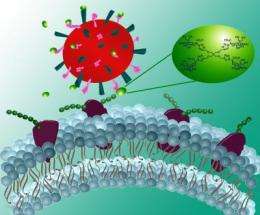A new way of the treating the flu: Approach targets both the H and N portions of the virus

(PhysOrg.com) -- What happens if the next big influenza mutation proves resistant to the available anti-viral drugs? This question is presenting itself right now to scientists and health officials this week at the World Health Assembly in Geneva, Switzerland, as they continue to do battle with H1N1, the so-called swine flu, and prepare for the next iteration of the ever-changing flu virus.
Promising new research announced by Rensselaer Polytechnic Institute could provide an entirely new tool to combat the flu. The discovery is a one-two punch against the illness that targets the illness on two fronts, going one critical step further than any currently available flu drug.
"We have been fortunate with H1N1 because it has been responding well to available drugs. But if the virus mutates substantially, the currently available drugs might be ineffective because they only target one portion of the virus," said Robert Linhardt, the Ann and John H. Broadbent Jr. '59 Senior Constellation Professor of Biocatalysis and Metabolic Engineering at Rensselaer. "By targeting both portions of the virus, the H and the N, we can interfere with both the initial attachment to the cell that is being infected and the release of the budding virus from the cell that has been affected."
The findings of the team, which have broad implications for future flu drugs, will be featured on the cover of the June edition of European Journal of Organic Chemistry.
The influenza A virus is classified based on the form of two of its outer proteins, hemagglutinin (H) and neuraminidase (N). Each classification - for example H5NI "bird flu" or H1N1 "swine flu" - represents a different mutation of hemagglutinin and neuraminidase or H and N.
Flu drugs currently on the market target only the neuraminidase proteins, and disrupt the ability of the virus to escape an infected cell and move elsewhere to infect other healthy cells. The new process developed by Linhardt is already showing strong binding potential to hemagglutinin, which binds to sialic acid on the surface of a healthy cell, allowing the virus to entire the cell.
"We are seeing promising preliminary results that the chemistry of this approach will be effective in blocking the hemagglutinin portion of the disease that is currently not targeted by any drug on the market," he said.
In addition, Linhardt and his team have shown their compound to be just as effective at targeting neuraminidase as the most popular drugs on the market, according to Linhardt.
The approach can also be modified to specifically target the neuraminidase or the hemagglutinin, or both, depending on the type of mutation that is present in the current version of the flu, according to Linhardt.
In the next steps of his research, Linhardt will look at how their compounds bind to hemagglutinin, and he will test the ability to block the virus first in cell cultures and then in infected animal models.
"It is still early in the process," he said. "We are several steps away from a new drug, but this technique is allowing us to move very quickly in creating and testing these compounds."
The technique that Linhardt used is the increasingly popular technique of "click chemistry." Linhardt is among the first researchers in the world to utilize the technique to create new anti-viral agents. The process allows chemists to join small units of a substance together quickly to create a new, full substance.
In this case, Linhardt used the technique to quickly build a new derivative of sialic acid. Because it is chemically very similar to the sialic acid found on the surface of a cell, the virus could mistake the compound as the real sialic acid and bind to it instead of the cell, eliminating the connections to hemagglutinin and neuraminidase that are required for initial infection and spread of the infection in the body. The currently available drugs are translation-state inhibitors whose chemical structure allows them to only effectively target the neuraminidase.
Source: Rensselaer Polytechnic Institute (news : web)















